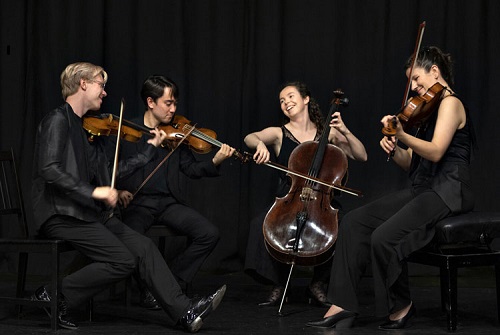
 United Kingdom BBC Proms at Cadogan Hall [2] – Haydn, Simpson: The Marmen Quartet (Johannes Marmen, Ricky Gore [violins], Bryony Gibson-Cornish [viola], Sinéad O’Halloran [cello]). Cadogan Hall, London, 16.8.2021. (CS)
United Kingdom BBC Proms at Cadogan Hall [2] – Haydn, Simpson: The Marmen Quartet (Johannes Marmen, Ricky Gore [violins], Bryony Gibson-Cornish [viola], Sinéad O’Halloran [cello]). Cadogan Hall, London, 16.8.2021. (CS)

Joseph Haydn – String Quartet in D major Op.64 No.5, ‘The Lark’
Robert Simpson – String Quartet No.1
In the ’90s, I was an undergraduate student in search of a final-year dissertation topic. I was leaning towards Sibelius’s symphonies, particularly the last three works, and the question of ‘influences’ – on the Finnish symphonist and on those whom Sibelius’s quests to extend and realise symphonic form subsequently inspired. A chance remark during a summer job at Peters Edition prompted me to purchase a CD of the Ninth Symphony of Robert Simpson (1921-1997), performed by the Bournemouth Symphony Orchestra under Vernon Handley. I loved it and began borrowing and begging for other recordings and scores of Simpson’s symphonies and string quartets. Back at university in the autumn, I embarked upon my research, devouring Simpson’s writing on not just Sibelius but Nielsen and Beethoven too. Naïve but enthusiastic, I wrote to Simpson at his home in Tralee Bay, Kerry, about the influence of Sibelius on his music, and about his thoughts on symphonic form more generally. Generous and encouraging, he wrote back. My dissertation eventually changed tack but I still have, and treasure, Simpson’s letter.
Which is all a rather long-winded way of saying that I was thrilled to see Simpson’s First String Quartet (1951-52) programmed alongside the work to which it alludes, Haydn’s ‘Lark’ Quartet, in the Marmen Quartet’s lunchtime Prom at Cadogan Hall, marking the 100th anniversary of Simpson’s birth. And, not least because if Simpson, despite an enthusiastic band of devotees (including the Delmé, the Coull and the Vanbrugh Quartets) was not oft performed in his lifetime, then his music – which includes fifteen string quartets and eleven symphonies – seems to be an even rarer visitor to the concert hall today. Yet, Simpson’s commitment to the continued development of symphonic thinking in the 20th century resulted in a body of work that surely rivals, even exceeds, that of any English symphonist or composer of string quartets.
Simpson was described by Hans Keller as ‘the perpetual striver … who thinks it is better to travel than to arrive – who suspects arrival as an illusion, an excuse for not continuing to strive’, and his fifteen string quartets span 40 years. The first three were composed during the 1950s, the same decade in which Simpson joined the BBC as a producer and broadcaster. During the following 30 years he frequently clashed with the corporation’s management, and in 1980 resigned – forgoing a generous pension – in protest at proposed cuts to the BBC orchestras and what he (and others, including Keller and Deryck Cooke) considered the dumbing down of programming and political manipulation driven by financial priorities. Following his resignation Simpson wrote a polemical booklet, The Proms and natural justice, in which he argued that no one person should hold sway over the programming of the Proms for an indeterminate period, since individual predilection and taste limited the range of repertoire offered to the listener, and in particular had denied them the opportunity to hear the music of past and contemporary British composers.
One hopes that Simpson would be pleased by the decision of the Marmen Quartet – which was formed in 2013 at the Royal College of Music – to place his First Quartet alongside Haydn’s ‘Lark’, since this 1951 quartet exemplifies Simpson’s commitment to the constant conversation with and renewal of musical tradition, and his own love of the Classical string quartet, particularly those of Haydn and Beethoven.
The Allegro moderato, semplice began calmly – Haydn’s bird made its presence felt – but despite the gentle gestures there was a sense of expansiveness, and also an inner energy which surged urgently through the rushing unisons which unfolded. Throughout the movement the Marmen thoughtfully counterposed the irrepressible motion with passages of tranquillity, Sinéad O’Halloran soft golden lyricism interrupted by the silvery scurrying of the violinists, Johannes Marmen and Ricky Gore. The music always seemed to be searching and developing; small motifs continuously evolved, moments of rest were disturbed by rustles which grew into taut fugatos, charging scales and busy density. The Marmen’s clear contrapuntal textures and sonorities, and the equality of the voices, served Simpson’s music potently.
Bryony Gibson-Cornish’s unaccompanied viola theme had a serene, if slightly eerie, stillness as it quietly rose and fell at the start of the Andante, grave. As the theme was subject to palindromic variation, the entries of the other instruments opened up of the tessitura and the gentle lyrical explorations were poetic and pensive, preciously phrased by the Marmen Quartet. Unisons again created impetus and the transition to the more impassioned Allegro was persuasively shaped, the two-note pattern which opened the movement developing into turbulent counterpoint which culminated in Marmen’s ecstatic high cadenza-like arabseques above richly blended chords. Then, a quietening, and reminiscences of the first-movement theme, before the simplicity of the concluding dance for the first violin, lightly propelled by warm pizzicatos. Simpson remarked that this innocent theme came to him during a sunny afternoon in Regent’s Park: ‘Perhaps there is something wistful about the music hence the marking poco pensoso’. The soft warmth of the final, reassuring consonance did indeed seem an affectionate glance back at the Classical masters.
The concert opened with the genteel avian melodising of Haydn’s ‘Lark’ Quartet. The staccato lower strings hopped with carefree cheerfulness at the start of the Allegro moderato, while Marmen’s bird soared gently, its song a pianissimo whisper as it surfed the breezes, its fluttering grace notes delicate whisps. There was a lovely freshness and spaciousness, but the Marmen judiciously used Haydn’s syncopations to create breadth, despite the march-like step of the opening. All was elegant, the ensemble and tuning immaculate, though more robustness as the material developed might have been welcome. And, at times Marmen’s lark seemed a little reticent, particularly in the subsequent double restatement of the theme.
The same grace and sweetness characterised the Adagio Cantabile, but again I felt that Marmen might have created greater light and shade in his aria, the phrases of which have innate expressive peaks. The tone, of the violin solo and the ensemble whole, was beautiful, but the emphasis on elegance and restraint lessened the drama that Haydn’s dynamic contrasts, melodic elaborations and darker harmonic explorations – especially in the central section – imbue. The Menuetto was a courteous, patrician dance. The warm exchanges of the lower two strings added shape and movement, though occasionally it felt as if the twirls might spin precariously away, as the grace notes and staccatos of the two violins tumbled downwards. The minor key excursion and chromatic inflections of the Trio didn’t really inject any clouds, so effortlessly serene were the staccato bow-strokes, so moderate the contrasts of colour and volume. The ‘hornpipe’ moto perpetuo of the Vivace had more bite, though, and here the Marmen’s clarity and light-footed crispness was a real asset, especially in the more democratic contrapuntal exchanges in which every galloping note spoke true and strong. As the music surged forward, the Marmen Quartet’s calm control was unwavering, their collective feathers not once ruffled.
Claire Seymour
This concert is available on BBC Sounds.